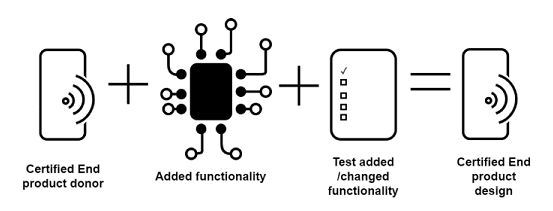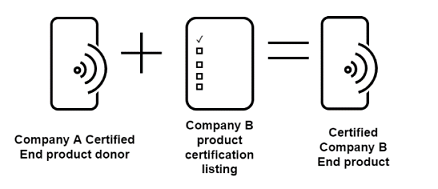Amazon Sidewalk qualification concepts
The following shows some key concepts of Amazon Sidewalk qualification.
Topics
- Types of Sidewalk devices
- Development keys and platforms
- Donor qualification listing
- Software updates on end-products
Types of Sidewalk devices
There are three types of Amazon Sidewalk products.
End products
An end product is the final product of a Works with Amazon Sidewalk qualified design. End products may be sold, hired or otherwise transferred to end users. Qualified end products may be used on the Amazon Sidewalk network.
End products are Sidewalk Endpoints that connect to Gateways using the Amazon Sidewalk protocol. The end products may be produced by Amazon or other developers.
Subsystem
A subsystem implements part of the Works with Amazon Sidewalk qualification requirements. It doesn’t implement the functionality of a complete Amazon Sidewalk end product. Examples of subsystems include: a system on a chip (SoC), a module, a hardware development kit (HDK), or a software development kit (SDK).
Prototype devices
Prototyping is undertaken for experimental or test purposes. A prototype is a device that is used during product development as a preliminary version.
Important A prototype is intended for use by a developer, and is not intended for sale, hire, or other transfer to a customer end user.
These devices may be produced by Amazon or a third party. The prototype devices don’t have to be Amazon Sidewalk-qualified. However, prototype devices may contain subsystems that are Amazon Sidewalk-qualified.
Development keys and prototypes
Amazon may provide Development Keys to enable development of Amazon Sidewalk Endpoints. The keys must be used only for development and debugging purposes. A Development Key is time-limited and grants temporary access to the Amazon Sidewalk network, so it must be used in accordance with all applicable Amazon terms.
Amazon reserves the right to revoke Development Keys if their use disrupts operation of the Amazon Sidewalk Network, therefore developers should conduct early stage development in an isolated environment.
Amazon expects that Development Keys will only be issued for Development prototypes. A different type of Key is used for end products that are mass-produced.
Limitations on development prototypes
Development prototypes may be granted time-limited access to the Amazon Sidewalk network for testing purposes. In most cases, development prototypes will be based on qualified designs and no testing will be required for time-limited access.
Amazon reserves the right to require developers to submit a subset of Works with Amazon Sidewalk qualification test evidence to ensure that development devices do not negatively impact Amazon Sidewalk network capabilities. For example, a completely new platform that’s not based on existing designs may be required to demonstrate correct behavior using a test Gateway.
Donor qualification listing
A donor qualification listing is an Amazon Sidewalk qualification listing that can be used as part of another qualification listing. A donor qualification listing donates functionality to another listing. Examples of donor qualification listings include:
Topics
- A certified partial product integrated into an end product design
- An end product reused to provide additional capabilities
- A listing that is re-registered for new end product listing
A certified partial product integrated into an end product design
A certified partial product that implements a subset of the Amazon Sidewalk requirements can act as a donor to be integrated into end products. For example, a Silicon Vendor can produce an Amazon Sidewalk chip or module that can be integrated into an end product. In this case, the module doesn’t implement all the required functionality to be an end product. Tests corresponding to the changed functionality as part of the integration must be added for a certified end product design.

An end product reused to provide additional capabilities
A full end product can act as a donor by reusing it in a qualification listing to add extra functionality. In this case, if some tests are unchanged between versions and the functionality to pass those tests is also unchanged in the device, then those tests are not required to be repeated on each new qualification and instead can be inherited from the unchanged parts of the donor qualification listing.
A donor qualification listing could also be a complete implementation of a consumer end product that is being reused in a listing to provide additional functionality. For example, an Amazon Sidewalk Endpoint that supports a version of the Amazon Sidewalk specification could act as a donor qualification listing, providing functionality to another Endpoint that supports a newer version of the specification. In this case, if certain tests are unchanged between versions and the functionality to pass the tests is also unchanged, then the tests corresponding to the unchanged parts are not required to be repeated and can be inherited from the donor listing.
Certain RF or security tests might still need to be rerun. To determine the tests that must be run, see the test specifications document, or contact the test facility for details on tests that can be inherited.

A listing that is re-registered for new end-product listing
A donor qualification listing can be a listing that’s re-registered unchanged because a complete Sidewalk system is reused in a different product. For example, Company A designs a Sidewalk system that can be attached to different switches or sensors. Company B licenses that design to attach to a sensor and qualifies their product. In this case, the Sidewalk functionality is unchanged, and so it wouldn’t require any retesting. To qualify your end-product, you’ll only need to create a new qualification listing with the contact details and information about Company B’s end-product.

Software updates on end-products
Endpoint manufacturers are required to have a software maintenance update strategy that specifically defines how updates will be created and distributed.
Manufacturers with designs that are based on the Amazon Sidewalk Protocol stack receive security updates, and manufacturers are responsible for integration and distribution of those updates into End-products.
For each vulnerability, Amazon provides a time window for updates. The default window is 90 days for critical and high severity vulnerabilities and six months for medium severity updates, as defined by NIST CVSSv2. Updates for low severity vulnerabilities should be prioritized in future updates where feasible and applicable.
‘Manufacturer’ means the company identified in the qualification, not a contract manufacturer.
Important
Manufacturers shall release security updates for a minimum period of time that is no less than 4 years from the last shipping date of the device.
For a device that cannot be upgraded over the air (OTA), manufacturers shall commit to making upgraded hardware available in the event of a critical security update. The upgrade path is defined by the manufacturer, with options including:
- Users purchase replacement hardware
- Users are provided with free replacement hardware
- Users trade in existing hardware for reconditioned upgraded hardware
- Users are provided with an alternative path for upgrading hardware. For example, using a non-Sidewalk secure protocol to upgrade.
For a device that cannot be upgraded over the air, manufacturers shall make the upgrade period and upgrade mechanism known at the time of purchase.
If a manufacturer fails to create and distribute a software maintenance update within the periods defined above, after discovery of a vulnerability, Amazon reserves the right to restrict access to Amazon Sidewalk network services for those end-products.
Amazon also reserves the right to deny new products from that manufacturer access to the Works with Amazon Sidewalk qualification.
If a manufacturer has mitigating circumstances that make updates within the default window for updates impractical, they may apply to Amazon for an extension of the required update period. Applications for extensions to the required update period shall be routed through support channels (for end product manufacturers, applications are routed through the silicon provider).